Circular economy: strategies for concrete buildings
Designers can help shift our throwaway culture to a circular one by extracting the maximum value from building structures, writes Elaine Toogood
 There is a growing recognition among governments, businesses and the public that we urgently need to transform our take-make-dispose economy into a circular one, in which resources are kept in use for as long as possible while maximum value is extracted. In this way, we can reduce the environmental impact of human activities and the waste that they generate, make our societies more resilient to future shocks and supply issues, and ensure that we continue to meet the needs of future generations while living in balance with the natural systems that we rely upon.
There is a growing recognition among governments, businesses and the public that we urgently need to transform our take-make-dispose economy into a circular one, in which resources are kept in use for as long as possible while maximum value is extracted. In this way, we can reduce the environmental impact of human activities and the waste that they generate, make our societies more resilient to future shocks and supply issues, and ensure that we continue to meet the needs of future generations while living in balance with the natural systems that we rely upon.
Achieving this will involve significant, sustained change in every part of society – and we need to start now. This article will consider the strategies that designers can adopt to maximise concrete structures’ potential in a circular economy, and ensure that they are fit for purpose for a world in which resource use is radically lower and no material is wasted.
Reuse
Reusing a building structure is the most effective way to keep its materials in use for as long as possible and to extract the maximum value from them and the benefits of retaining and reusing concrete frames are increasingly recognised by designers, developers and planners. This may involve expanding and improving an existing building so that it can continue to perform the same function as user needs evolve, as at The Bower in London’s Shoreditch where AHMM repurposed two tired 1960s office buildings (CQ 268). Or it might mean using the shell of a redundant building to fulfil a completely different purpose – such as ORMS’ conversion of Camden council’s old offices into a home for boutique hotel chain The Standard (CQ 270).
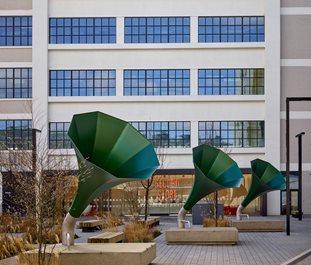
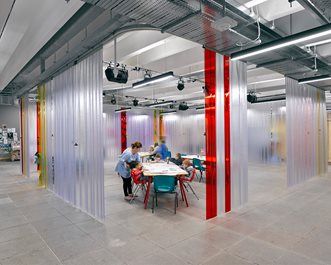

This strategy reduces the demand for new materials, and the embodied carbon associated with new development. Retaining the existing concrete in buildings also provides the opportunity to tap into its thermal mass and so reduce operational energy use. For example, at Elizabeth II Court in Winchester by Bennetts Associates (CQ 255), coffered ceilings were exposed and became central to the new heating and cooling strategy.
Images (1) The Record Store in Hayes, west London. AHMM has transformed this 1927 art deco record factory into a modern office building. (2) Featherstone Young’s Ty Pawb in Wrexham reinvents an ageing car park as an arts centre and market. (3) The Pirelli Tire Building in New Haven, Connecticut by Marcel Breuer. This brutalist 1970s office building has recently been reimagined as a net-zero energy hotel by Becker + Becker.
Photos Timothy Soar / AHMM, Pat Krupa / flickr; James Morris
Design for future reuse
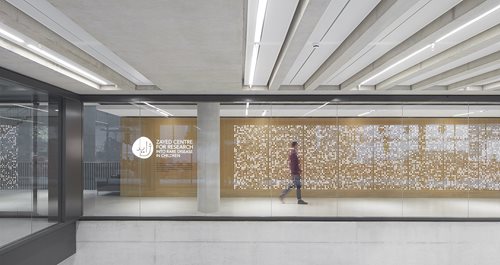 Where a new structure or building is required, this should be designed to optimise future reuse, so embedding good circular economy practice. Here, the durability of concrete is an advantage. According to the design standards for a concrete frame located internally – in other words, in an environment classed as “low exposure” – no additional measures are required to achieve a service life of over 100 years compared to 50. (See BS 8500-1, tables A4 and A5, XC1 exposure class.)
Where a new structure or building is required, this should be designed to optimise future reuse, so embedding good circular economy practice. Here, the durability of concrete is an advantage. According to the design standards for a concrete frame located internally – in other words, in an environment classed as “low exposure” – no additional measures are required to achieve a service life of over 100 years compared to 50. (See BS 8500-1, tables A4 and A5, XC1 exposure class.)
The inherent low maintenance requirements of a concrete structure, and its resilience to fire and the impacts of weather, mean that it can remain serviceable over a long period, with the potential for multiple reuses during its lifetime. The key to optimising this therefore lies not so much in the material itself, but rather in the way that it is designed. The “long life loose fit” approach to design is well established and can ensure future functionality through consideration of spans, optimum loads, regular grids and generous floorto- ceiling heights. The many lessons being learned through current retrofit projects will also help inform the futureproofing of today’s new buildings.
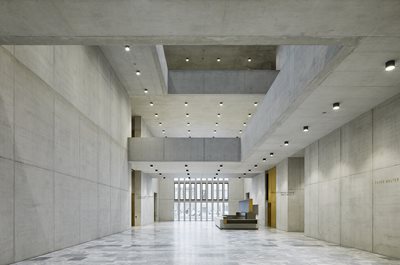 Design for disassembly and reuse can also maximise the lifespan of both individual components and the building structure itself. This is particularly applicable for parts of a building that are likely to be changed or replaced more frequently, such as fixtures and fittings, but is being increasingly considered for more integral elements such as cladding. Designing the less permanent layers in this way increases the reuse potential of the underlying structure by making it easier to upgrade it or to strip it back to facilitate an alternative use.
Design for disassembly and reuse can also maximise the lifespan of both individual components and the building structure itself. This is particularly applicable for parts of a building that are likely to be changed or replaced more frequently, such as fixtures and fittings, but is being increasingly considered for more integral elements such as cladding. Designing the less permanent layers in this way increases the reuse potential of the underlying structure by making it easier to upgrade it or to strip it back to facilitate an alternative use.
Structural elements themselves can also be designed for disassembly, especially for buildingsthat have relatively short lifespans. This is an approach that is already taken for precast concrete products, such as stairs and stadium seating, fencing, barriers and paving. For example, the upper tiers of London’s 2012 Olympic stadium are fully demountable so that they can be reused elsewhere, though for now they continue to fulfil their original function as the home of West Ham United – a good example of the circular economy hierarchy in practice. In this way, concrete structures should be viewed as a useful resource for future development.
Images (1) At the Zayed Centre in central London designed by Stanton Williams, the use of posttensioned flat slabs with clear spans and very few downstands will help to enable future reconfiguration. (2) David Chipperfield Architects’ Kunsthaus Zurich was built from 98% recycled concrete. In Zurich, to qualify as recycled concrete for use on public buildings, it must contain either 50% recycled concrete aggregate or 25% mixed demolition waste aggregate.
Photos Huftom + Crow, Noshe
Recycling concrete
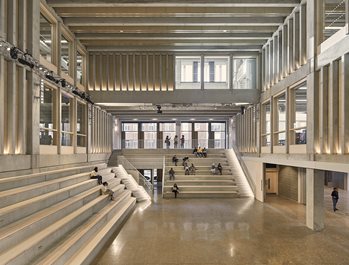 When concrete does eventually reach the end of its life, it can be recycled. This applies to all concrete, and the process can be repeated again and again in perpetuity to provide a lowcarbon resource with a range of applications. The majority of concrete’s volume/mass is aggregates, and when recycled, it becomes aggregate again. Some of this makes its way back into new concrete, but most is used “unbound” as sub-base materials, fill and hard core. Here, one industry’s waste is another’s raw material. Already, over 90% of the UK’s hard construction, demolition and excavation waste, of which concrete is a significant proportion, is diverted from landfill for use in construction.
When concrete does eventually reach the end of its life, it can be recycled. This applies to all concrete, and the process can be repeated again and again in perpetuity to provide a lowcarbon resource with a range of applications. The majority of concrete’s volume/mass is aggregates, and when recycled, it becomes aggregate again. Some of this makes its way back into new concrete, but most is used “unbound” as sub-base materials, fill and hard core. Here, one industry’s waste is another’s raw material. Already, over 90% of the UK’s hard construction, demolition and excavation waste, of which concrete is a significant proportion, is diverted from landfill for use in construction.
The UK’s geology can provide a long-term supply of low-carbon, local, responsibly sourced natural aggregates for use in concrete. As recognised in the latest version of BREEAM New Construction, this can often prove to be the most sustainable solution. Elsewhere, in countries without this security of supply, there will be a greaterneed to use recycled aggregates in new concrete and the technical capability to do so is developing (see case study).
Image Kingston Townhouse in Surrey by Grafton Architects. Generous open-plan floor plates with long spans and high floor-loading capacity offer long-term flexibility as users’ needs change.
Photo Ed Reeve
Concrete’s role in reusing other materials
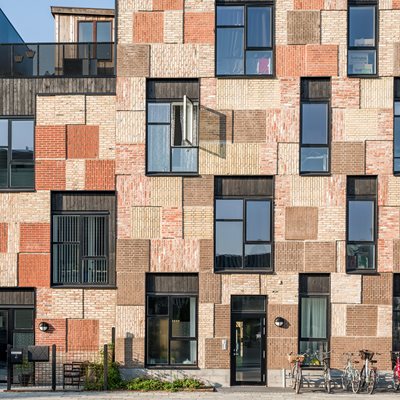 Most concrete contains some recycled material, and each of its principle constituent parts – aggregate, water, cement and reinforcement – can include recycled content. Common secondary cementitious materials such as GGBS and fly ash are, for example, by-products of other industries and the latest data shows that most steel reinforcement made in the UK uses about 96% recycled steel.
Most concrete contains some recycled material, and each of its principle constituent parts – aggregate, water, cement and reinforcement – can include recycled content. Common secondary cementitious materials such as GGBS and fly ash are, for example, by-products of other industries and the latest data shows that most steel reinforcement made in the UK uses about 96% recycled steel.
As a structural material, quality control and performance are understandably paramount. The allowable percentage of recycled aggregate content varies according to the intended use of the concrete, its location and the durability requirements, but also the type or grade of aggregate. Recycled aggregate (RA) results from the reprocessing of inorganic material previously used in construction, such as masonry rubble. Crushed concrete aggregate (CCA) is a form of RA but principally comprised of crushed concrete.
Typically, lower strength and unreinforced concrete can contain 100% CCA as coarse aggregate permitted in GEN (general concrete) designations. Many other designated concretes can contain up to 20% CCA without special declaration. Higher percentage replacements are technically possible, provided the aggregate is tested to show it meets the required quality. It is worth noting that in comparison with the typically local and low carbon natural aggregates available in the UK, recycled aggregates can sometimes raise the embodied carbon of concrete, particularly where more cement content is required to meet required strengths.
Another source of recycled content is secondary aggregates – by-products of other industrial processes. These materials, such as air-cooled blast-furnace slag and china clay waste, also known as stent, have similar properties to primary or natural aggregates and are commonly used as an alternative fine or coarse aggregate in concrete in some parts of the country. Around the world, there are many research projects that seek to use local waste resources in concrete – from coffee grounds and plastics to shredded car tyres or oyster shells.
The ability of concrete to “hold” other elements in its surface using aggregate transfer or seeding – well-established processes for embedding material into the surface of concrete – can also facilitate the reuse other waste materials into useful construction products, such as waste bricks in concrete cladding panels. With the growing emphasis on circular economy principles, further innovations and examples of good practice will no doubt emerge.
Image At Resources Row in Copenhagen, architect Lendager reused old bricks by angle-grinding entire sections of existing walls and embedding them into precastconcrete facade panels.
Photo Rasmus Hjortshøj
Elaine Toogood, head of architecture at The Concrete Centre